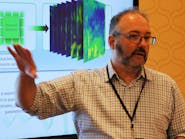Shawn Murphy’s background is in astrophysics, but at heart he’s a serial entrepreneur. He is currently founder, CTO and CEO of Titan Advanced Energy Solutions (AES), his fourth startup. Moss does not grow on Shawn Murphy. He moves too fast for that.
Headquartered in Salem, Massachusetts, Titan AES conducts high-resolution ultrasound scanning of lithium-ion battery cells for defect detection with its IonSight technology, but Murphy might tell you that Titan AES is really a data company.
“We don’t sell equipment,” he explained in a presentation during Gigafactory Day at this week’s 2024 Honeywell Users Group meeting in Dallas. “We give battery insights.”
Whether by coincidence or as a designed part of the Gigafactory Day celebration, Titan AES successfully delivered its new “Big Titan” scanning machine to a European battery manufacturer just hours before Murphy’s presentation.
The system was designed in the first quarter of 2024, and its manufacture began in April. The full system was assembled in August and tested in September. The factory acceptance test was passed on September 18, and it was disassembled into four blocks and shipped less than a week later.
Big battery data
Titan’s system averages about 25,000 voxels per cell. A voxel is the three-dimensional counterpart to a pixel. The system is cell-chemistry-agnostic and can scan up to 60 parts per minute with real-time data analysis. “We process the cell in one second,” explained Murphy. “You have to extract the relevant data and process it at the same time.”
For inspection, the battery passes into the Big Titan’s interrogation zone. “We digitally slice the battery into seven or eight layers that are all packed with an enormous amount of information. Then we apply algorithms. A typical battery has half a million to 750,000 data points. It’s not just voltage and current. We’re processing 50,000 batteries a day. We have petabytes of data. We understand their anode type, their formation process, their electrolyte process.”
The IonSight system detects common cell manufacturing defects, including:
- Electrochemical defects, such as lithium plating, moisture contamination or electrolyte decomposition,
- Process defects, such as poor electrolyte wetting or residual gas from formation,
- Mechanical defects, such as electrode delamination, electrode misalignment or electrode tears, and
- Mechanical defects, such as separator wrinkling or separator tear.
“You can have layer misalignment in prismatic cells,” added Murphy. “Misalignment increases the risk of thermal runaway.”
IonSight use cases include:
- Optimizing existing quality gates for electrode misalignment detection, capacity measurement, ambient aging optimization and tab detachment detection,
- Augmentation of existing quality gates for electromechanical defect detection, process defect detection, mechanical defect detection and charge mapping,
- Increasing process yields with corrective and preventive actions management, and
- Introduction of a new quality gate, such as capacity degradation prediction.
Titan AES resulted from the convergence of two revolutions—electrification and information, Murphy says. Electrification describes the generation, transmission and usage of power, while information encompasses the design, generation and usage of data. “Electrification is now in residential, industrial, communication and automotive applications,” said Murphy, “and one key enabling factor is batteries.”
Information usage, on the other hand, takes the shape of personal computers, cloud storage, data farms and artificial intelligence. “The key enabling factor is data. Without data, you have no AI,” noted Murphy.
“Ultransonics allow Titan to look inside the battery and understand it.”
About the Author
Mike Bacidore
Control Design
Mike Bacidore is chief editor of Control Design and has been an integral part of the Endeavor Business Media editorial team since 2007. Previously, he was editorial director at Hughes Communications and a portfolio manager of the human resources and labor law areas at Wolters Kluwer. Bacidore holds a BA from the University of Illinois and an MBA from Lake Forest Graduate School of Management. He is an award-winning columnist, earning multiple regional and national awards from the American Society of Business Publication Editors. He may be reached at [email protected]

